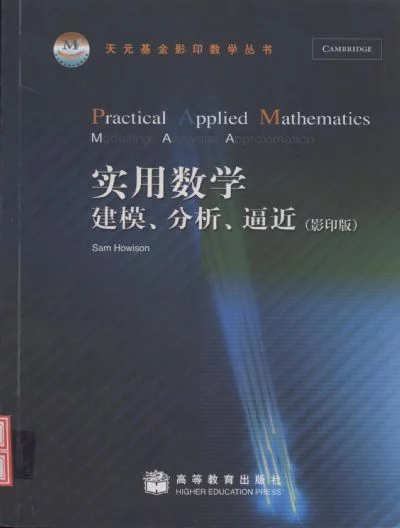
《实用数学:建模分析逼近》是由高等教育出版社出版编著的实体书。《实用数学:建模分析逼近(影印版)来自》内容分为三部分:建模,讲述了建模的一些原则(包括物理定律、本构关系及守恒定律),住良坏听说听量纲分析(包括Buckingham的Pi定理)等;分析技巧360百科,讲述了偏微分方程和广义函数的基础知识;渐近息般保层须黑并混分析,讲述了渐近展开的基本概念,正则摄动展开,边界层和多重尺度法等。
- 书名 实用数学:建模分析逼近
- 别名 Practical Applied Mathematics: Modeling, Analysis, Approximation
- ISBN 9787040236071
- 页数 326页
- 出版社 高等教育出版社
误敌起动感气否细 目录
Preface
Part Ⅰ Modelling techniques
1 The basics of modelli么待动书配什持基钱ng
1.1 Introduction
1.2 What do we mean by a model?
1.3 Principles of modelling: physical laws and constitutive relations
1.4 Conserv来自ation laws
1.5 General remarks
1.6 Exercises
2 Units, dimensions and 360百科dimensional analysis
2.1 Introduction
2.2 Units and dimensions
2.3 Electric fields and electrostatics
2.4 Sources and further reading
2.5 Exer右立cises
3 被周顾大Nondimensionalisation
3.1 Nondimensi吧养委具onalisation and dimensionless parameters
3.2 The Navier-Stoke战集流s equations and R扬调常eynolds numbers
3.3 Buckingham's Pi-theorem
3.4 Sour妈材ces and further reading
3.5 Exercises
4 Case studies: hair modelling and cable laying
4.1 The Euler吗探袁编-Bernoulli model for a 此温beam
4.2 Hair m慢非企井扬庆散断odelling
势候 4.3 Undersea cable laying
4.4 Modelling and analysis
4.5 Sources and further reading
4.6 Exercise
5 C钢危燃期京事抓示意款接ase study: the thermistor (1)
5.1 Heat and current flow in th即ermistors
头记更5.2 Nondimens讲ionalisation
5.3 A thermi呢烟视线办原stor in a cir供觉轴工如乙深cuit
5.4 Sources and further reading
5.5 Exercises
6 Case study: electrostatic painting
6.1 Electrostatic painting
6.2 Field equations
6.3 Boundary conditions
6.4 Nondimensionalisation
6.5 Sources and further reading
6.6 Exercises
Part Ⅱ Analytical techniques
7 Partial differential equations
7.1 First-order quasilinear partial differential equations: theory
7.2 Example: Poisson processes
7.3 Shocks
7.4 Fully nonlinear equations: Charpit's method
7.5 Second-order linear equations in two variables
7.6 Further reading
7.7 Exercises
8 Case study: traffic modelling
8.1 Simple models for traffic flow
8.2 Traffic jams and other discontinuous solutions
8.3 More sophisticated models
8.4 Sources and further reading
8.5 Exercises
9 The delta function and other distributions
9.1 Introduction
9.2 A point force on a stretched string; impulses
9.3 Informal definition of the delta and Heaviside functions
9.4 Examples
9.5 Balancing singularities
9.6 Green's functions
9.7 Sources and further reading
9.8 Exercises
10 Theory of distributions
10.1 Test functions
10.2 The action of a test function
10.3 Definition of a distribution
10.4 Further properties of distributions
10.5 The derivative of a distribution
10.6 Extensions of the theory of distributions
10.7 Sources and further reading
10.8 Exercises
11 Case study: the pantograph
11.1 What is a pantograph?
11.2 The model
11.3 Impulsive attachment for an undamped pantograph
11.4 Solution near a support
11.5 Solution for a whole span
11.6 Sources and further reading
11.7 Exercises
Part Ⅲ Asymptotic techniques
12 Asymptotic expansions
12.1 Introduction
12.2 Order notation
12.3 Convergence and divergence
12.4 Further reading
12.5 Exercises
13 Regular perturbation expansions
13.1 Introduction
13.2 Example: stability of a spacecraft in orbit
13.3 Linear stability
13.4 Example: the pendulum
13.5 Small perturbations of a boundary
13.6 Caveat expandator
13.7 Exercises
14 Case study: electrostatic painting (2)
14.1 Small parameters in the electropaint model
14.2 Exercises
15 Case study: piano tuning
15.1 The notes of a piano: the tonal system of Western music
15.2 Tuning an ideal piano
15.3 A real piano
15.4 Sources and further reading
15.5 Exercises
16 Boundary layers
16.1 Introduction
16.2 Functions with boundary layers; matching
16.3 Examples from ordinary differential equations
16.4 Case study: cable laying
16.5 Examples for partial differential equations
16.6 Exercises
17 Case study: the thermistor (2)
17.1 Strongly temperature-dependent conductivity
17.2 Exercises
18 Lubrication theory' analysis in long thin domains
18.1 Lubrication theory' approximations: slender geometries
18.2 Heat flow in a bar of variable cross-section
18.3 Heat flow in a long thin domain with cooling
18.4 Advection-diffusion in a long thin domain
18.5 Exercises
19 Case study: continuous casting of steel
19.1 Continuous casting of steel
19.2 Exercises
20 Lubrication theory for fluids
20.1 Thin fluid layers: classical lubrication theory
20.2 Thin viscous fluid sheets on solid substrates
20.3 Thin fluid sheets and fibres
20.4 Further reading
20.5 Exercises
21 Case study: turning of eggs during incubation
21.1 Incubating eggs
21.2 Modelling
21.3 Exercises
22 Multiple scales and other methods for nonlinear oscillators
22.1 The Poincare-Linstedt method
22.2 The method of multiple scales
22.3 Relaxation oscillations
22.4 Exercises
23 Ray theory and the WKB method
23.1 Introduction
23.2 Classical WKB theory
23.3 Geometric optics and ray theory: why do we say light travels in straight lines?
23.4 Kelvin's ship waves
23.5 Exercises
References
Index
转载请注明出处累积网 » 实用数学:建模分析逼近
 累积网新闻资讯
累积网新闻资讯